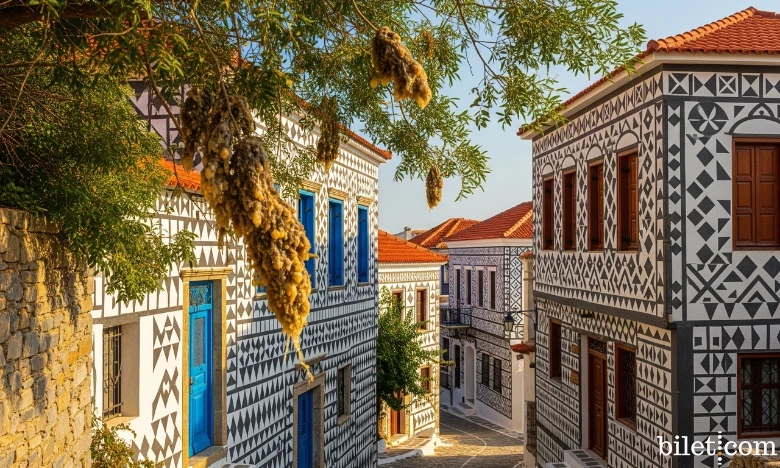Origin of the Name: Meaning of the Words "Chios" and "Gum"
The name of Chios is directly linked to its most precious treasure:-
Masticha (Μαστίχα): The name "Masticha" in Turkish comes from the aromatic resin known as "masticha" obtained from mastic trees (Pistacia lentiscus var. chia) growing in the south of the island. This mastic has been renowned since ancient times for both its commercial value and its healing properties. The island is one of the only places in the world where mastic is commercially produced.
-
Chios (Χίος): There are several different theories about the origin of the Greek name of the island, "Chios". According to mythology, the island was named after Chios, the son of Poseidon, the God of the Sea. According to another legend, it is said to have come from Chione (Greek "chioni" means snow), the daughter of Oinopion, the first king of the island; this is associated with the gods setting foot on the island while it was snowing on a winter day. Some linguists suggest that the name is derived from a word meaning "mastic" (gum) in the Phoenician or Syriac languages.
Mythological Whispers: From Homer to the Wine Gods
Chios has strong ties to Homer , the greatest poet of the ancient world. Many ancient sources claim that Homer was born or lived on Chios for many years. It is believed that Homer sat at a site known as Daskalopetra ("Teacher's Stone") in the north of the island, teaching his students and reading his epics.In addition, the island is also associated with wine in mythology. According to legend, Oinopion , the son of Dionysus, the God of Wine (or Minos, King of Crete), became the first king of the island and taught the island how to grow grapes and make wine. Ancient Chios wine (Ariousian wine) was quite famous and valuable in the ancient world.
A Journey Through the Depths of History: From the Ionians to the Genoese, from the Ottomans to the Present Day
Chios has been an important centre throughout history thanks to its strategic location and rich resources.-
Ancient and Classical Periods: Colonized by the Ionians, the island became a major maritime and commercial power. It became rich thanks to the wine and mastic trade. It joined the Athenian League and produced important names in the fields of art and literature.
-
Roman and Byzantine Period: Chios, which came under the rule of the Roman and then the Byzantine Empires, maintained its importance during these periods. Important religious structures, especially the Nea Moni Monastery, were built during this period.
-
Genoese Domination (1346-1566): The island came under the rule of the Genoese Justiniani family and was administered by a trading company called "Maona". During this period, the mastic gum trade reached its peak and the uniquely architectural Mastichochoria (Mastic Villages) were built in the south of the island. These villages were designed like fortresses to protect the mastic gum production and trade.
-
Ottoman Period (1566-1912): Chios Island, conquered by the Ottoman Empire, gained some privileges due to the importance of mastic in the Ottoman palace. Mastichochoria villages maintained their autonomy. However, the island was shaken by a tragic event during the Greek War of Independence in 1822, known in history as the "Massacre of Chios". In this event, tens of thousands of islanders lost their lives or were sold into slavery. A major earthquake in 1881 also caused serious destruction on the island.
-
Joined Greece: Joined Greece in 1912 after the Balkan Wars.
The Heart of Chios: Mastichochoria and Unique Beauties
Among the places that make Chios truly special are the Mastichochoria (Chios Villages) in the south of the island:-
Pyrgi: Famous for the geometric patterns called "xysta" on the exteriors of its houses. Decorated with black and white contrast, these houses resemble an open-air museum.
-
Mesta: With its labyrinthine streets, arched passages and well-preserved medieval architecture, it's like traveling back in time. From the outside, the village resembles a castle.
-
Olympi: This village, which has an architecture similar to Mesta, also has the Olympi Cave, known for its impressive stalactites and stalagmites.
-
Nea Moni Monastery: Built in the 11th century and listed on the UNESCO World Heritage List, this monastery is one of the important examples of Byzantine art with its magnificent mosaics.
-
Chios Town (Chora): In Chios Town, the center of the island, you can visit places such as the Kastro (Castle) from the Byzantine and Genoese periods, the Archaeological Museum, the Byzantine Museum and the Maritime Museum.
-
Mavra Volia and Vroulidia Beaches: Famous for its volcanic black pebbles, Mavra Volia and the adjacent Vroulidia are among the most impressive beaches on the island.
-
Kampos: A peaceful area located within citrus groves, famous for its stone mansions from the Genoese period (such as Argentikon).
-
Anavatos: The abandoned "ghost village" of Anavatos, built on a hill, has a sad history, particularly linked to the 1822 massacre.
Mastic: The Island's "Golden Tear"
Mastic gum, which is of vital importance for the economy and culture of Chios, is used not only in food and beverages (mastic ice cream, liqueur, coffee) but also in the pharmaceutical, cosmetic and varnish industries. This valuable resin, which leaks from the scratches made on the trunk of the mastic tree, is the symbol and source of pride of the island.Chios Island is a perfect getaway for those looking for a different experience in the Aegean, with its unique character, unspoiled texture, hospitable people and of course the unique aroma of mastic gum.
Now is the time to plan a trip to get lost in the authentic villages of Chios, listen to the story of mastic gum and discover the countless beauties that this unique island has to offer!







